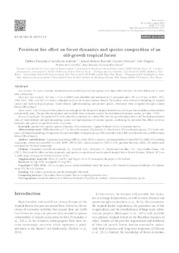Persistent fire effect on forest dynamics and species composition of an old-growth tropical forest.
Persistent fire effect on forest dynamics and species composition of an old-growth tropical forest.
Author(s): FERNANDES-CARVALHO-DE-ANDRADE, D.; RUSCHEL, A. R.; SCHWARTZ, G.; PEREIRA-DE-CARVALHO, J. O.; VASCONCELLOS-GAMA, J. R.
Summary: Aim of study: To assess structure, recruitment and mortality rates of tree species over almost three decades, 14 years before and 15 years after a forest fire. Materials and methods: All trees ≥ 5 cm in DBH were identified and measured in 12 permanent plots (50 m x 50 m), in 1983, 1987, 1989, 1995, 2008, and 2012 of a dense ombrophilous forest in Eastern Amazon, Brazil. The analyses were carried out including all sampled species and their ecological groups: shade-tolerant, light-demanding, and pioneer species. Treatments were compared through a Linear Mixed Effect Model. Main results: The 15-year post-fire period is not enough for the old-growth tropical forest to recover its pre-fire conditions of recruitment and mortality rates. The post-fire recruitment and mortality rates increased, mainly the recruitment of pioneer species (p-value < 0.05). Research highlights: In a period of 15 years after the occurrence of a surface fire, the old-growth tropical forest still has high recruitment rates of shade-tolerant and light-demanding species and high incidence of pioneer species, confirming the persistent fire effects on forest dynamics and species composition in this ecosystem
Publication year: 2021
Types of publication: Journal article
Unit: Embrapa Eastern Amazon
Observation
Some of Embrapa's publications are published as ePub files. To read them, use or download one of the following free software options to your computer or mobile device. Android: Google Play Books; IOS: iBooks; Windows and Linux: Calibre.
Access other publications
Access the Agricultural Research Database (BDPA) to consult Embrapa's full library collection and records.
Visit Embrapa Bookstore to purchase books and other publications sold by Embrapa.

